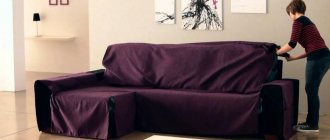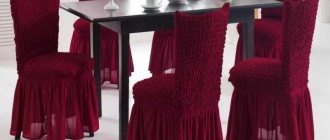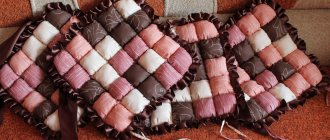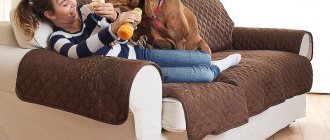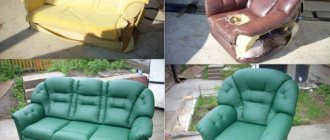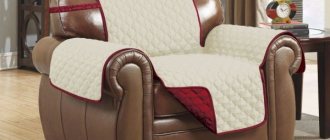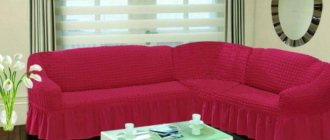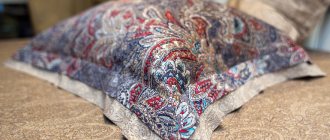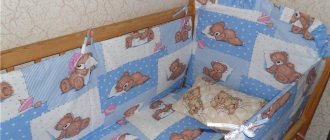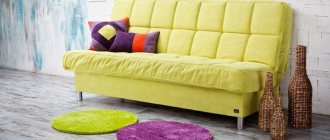The sofa is the main “character” in the living room. And if his condition leaves much to be desired, it immediately catches the eye. Even with careful handling, the upholstery quickly wears out and begins to shine. And if small children or pets regularly frolic on the sofa, then you can’t count on its safety at all. Scuffs, stains, and stains on upholstered furniture will not add respectability to your home. You can keep your sofa in its original form or give it a new life with the help of a removable cover. But finding a cape in a store that fits perfectly into the interior and is the right size is not so easy. We will tell you how to sew a sofa cover with your own hands and make your furniture stylish and impressive.
Advantages and disadvantages of sofa covers
The benefits of using self-made removable covers are obvious, since they:
- mask defects in old furniture;
- are much cheaper than completely reupholstering;
- give the interior uniqueness;
- do not require expensive cleaning;
- easily removable for washing or repair;
- allow you to quickly change the look of a room.
Among the disadvantages are:
- the need for additional spending of money and time;
- if the sofa serves as a sleeping place, and the cover prevents it from unfolding, the removable “upholstery” will need to be removed and put on daily;
- choosing a fabric that will not shrink and become covered with pills is not so easy.
You can combine disparate pieces of upholstered furniture using identical removable covers.
Advantages of a self-produced product
- Compared to restoration, this is a cheaper method.
- It is convenient to use and easy to wash.
- Opportunity to create your own unique design.
- The process does not require professional training and takes several hours.
- You can make several models and experiment with the appearance.
- If there are chairs from different sets next to upholstered furniture that are completely out of harmony, additional covers made for them will solve the problem.
- Handmade products are highly valued.
The fabric fades, is wiped out in places, stains, puffs, and others appear on it.
Since the cover will experience a lot of stress at the seams, especially if the pattern is very tight, some seams can be stitched twice.
Choosing fabric for the cover
Choosing the right material for the case is half the success. It depends on how long it will serve you. Protection for furniture should reliably protect the surface from dust and other contaminants, be durable and pleasant to the touch.
When choosing a material, you need to start from the purpose of the sofa. If it is used as a sleeping place, you should give preference to durable artificial fabrics - flock, velor, chenille. Intensive exploitation, even for 12 years, is not capable of violating their integrity. At the same time, they do not lose color under the influence of ultraviolet radiation and do not fade.
A cover for a children's sofa must meet environmental and safety requirements. In this case, the optimal choice is jacquard.
A flock cover with a velvety texture is perfect for the living room - a cozy, soft and at the same time incredibly durable and easy-to-clean material.
To make the cover impenetrable to the ubiquitous cat's claws, it should be made from a special fabric called relax. The material is similar to leather, contains durable thick pile and a layer of isoprene. Thanks to these features, the appearance of puffs on the surface is excluded.
Characteristics of various fabrics
- Velor is a synthetic or natural material with a velvety texture and high wear resistance.
- Flock is a highly durable, but soft and delicate fabric. Not subject to deformation and color changes. Any stains can be easily removed from the surface, the material does not become electrified and does not attract dust.
- Cotton - allows you to create bright covers for furniture. The natural composition makes it safe for the human body.
- Jacquard is a durable double-sided fabric. The presence of cotton, polyester and elastane makes the material resistant to deformation and damage.
Material
Any work related to needlework begins with the choice of fabric. When choosing a fabric, it is necessary to take into account that the main function of the cover is to protect the sofa upholstery from dust and various contaminants.
To sew an element on a sofa, you can purchase any material, there is a wide range. The following are very popular:
- velours;
- flock;
- Teflon flock;
- microfiber;
- cotton;
- jacquard.
Each fabric has its own characteristics and properties. No one can say which material is better. When choosing, you need to pay attention to the composition of the fiber. For furniture, preference is given to materials containing wool and cotton.
Velours
Jacquard
Microfiber
Flock
Cotton
Fabric for the cover must meet the requirements:
- practicality is important - the fabric should not require complex care;
- hypoallergenic - a person spends a lot of time on the sofa, the fabric must be safe for human health;
- should not accumulate static electricity;
- it is desirable that the cover can be washed or dry-cleaned in the future;
- the fabric should be soft to the touch and at the same time dense;
- The color must last for a long time.
When choosing, professionals recommend taking into account:
- External bright appearance is not the main indicator. The fabric must be wear-resistant;
- if there are babies and children in the house, then you need to choose a fabric that is durable and resistant to dirt and sharp claws;
- good fabric with special impregnation with fat and water-repellent. Then housewives will not be afraid of spilled tea or overturned food. The advantage of this material is that the cover is easy to wash.
Case shape and design
Before you start making a case, you need to think about its shape and decide on the size. There are various models. The cape can completely cover the elements of the sofa along with the legs and create the illusion of a complete floating object. Such products are suitable for classic, romantic, modern, English interiors.
Connoisseurs of modern styles will appreciate covers that ideally match the dimensions of the furniture or models presented in the form of separate covers for the seat and armrests. In this case, there is a taboo on any decorations - frills, bows, flounces. A good find for decorating such options is simple organizers in the form of pockets placed on the outside of the armrest. This is a great bonus for reading and app lovers. You can put a magazine, a regular or e-book, a tablet, headphones, a diary and many other small things you need in your pocket. Such models fit perfectly into high-tech and country, minimalism or eco-style.
The size and model of the cover affects the choice of fabric colors. If the canvas completely covers the furniture, then you should focus only on the general color palette of a particular interior. If it is only a small cape, it should be in harmony with the upholstery.
Advantages of a hand-sewn sofa cover
DIY sofa covers have the following advantages:
- relatively low cost;
- ease of use;
- ease of washing;
- the ability to bring furniture into line with the overall style of the interior;
- aesthetics;
- uniqueness.
By making several different models, you can experiment with the appearance of a piece of furniture. At the same time, such needlework requires very little time.
How to take measurements correctly and determine the size
To ensure that the cover fits like a glove, you need to take careful measurements and choose the right size. Products can be double, corner or dimensionless. To understand which product will be optimal in your case, you should measure the height of the sofa, as well as the length of its back. For example, the length of the back of a two-seater sofa can be from 120-150 cm, and the height can reach up to 100 cm.
You can sew a universal cover that will fit a sofa of any size. It can be easily pulled onto a sofa of any shape and size. The bottom and sides are assembled with thick elastic and are made of very durable and dense fabric.
How to choose a sofa deck?
The market offers a wide range of sofa decks in different colors and shapes. Even a discerning designer can choose a sample to his liking. When choosing sofa decks, you must take into account that the main thing for them is the durability and strength of the fabric. For the production of these products, heavy textiles are usually used: tapestry, velor, dense mixed fabrics based on cotton and synthetics. These fabrics do not get dirty for a long time and have a pleasant dense texture.
Master class on sewing a cover
We invite you to familiarize yourself with the tailoring of several options for removable sofa covers for products of various designs and dimensions.
Required tools and materials
To make a sofa cover you will need:
- paper - for creating a pattern;
- tape measure;
- chalk;
- textile;
- scissors;
- threads;
- needles;
- safety pins;
- wooden planks;
- sewing machine.
It is imperative to organize a spacious workplace where it will be convenient to create a drawing, cut out parts and assemble the product. The ideal option is a large folding table.
Cutting out parts
To create a pattern, you need to measure the furniture and transfer the measurements onto paper, observing all the bends and protrusions of the sofa. This matter is quite complicated, so we suggest simplifying the task. Take an old cover, open it up and make a pattern using it. Transfer the outline onto paper or directly onto fabric. If there is a flounce on the cover, then this detail can be drawn later. The finished pattern should be cut out, attached to the wrong side of the fabric and outlined with chalk. Be sure to leave seam allowances of at least 1 cm wide.
Sewing a cover for a sofa book
The process of making a cover for a sofa book is as follows:
- we make a pattern;
- transfer the drawing to the fabric - it is advisable to choose an elastic material;
- cut out the parts along the contour;
- we outline the area where the elastic will be located;
- we connect the pieces of fabric together - since the cover is a combination of several elements, the parts for the back, armrests and seat are assembled separately;
- We sew all the seams on the machine.
After completing all the steps, the protective covering for the click-klyak sofa or Eurobook will be completely finished.
Sewing a cover for a corner sofa
Making a cover for a corner sofa has its own characteristics. Necessary:
- attach the material to the sofa using safety pins;
- use pins to mark the sides, seat, back, armrests;
- sweep all the lines, trying to follow the curves of the furniture. You can use chalk;
- trim off excess fabric, remembering to leave seam allowances;
- connect the cut parts in pairs. We sew the back and seat elements separately;
- Unscrew the covers and try them on the furniture. If adjustments are necessary, mark problem areas where the seam needs to be narrowed or widened;
- we correct defects and sew seams using a machine.
Sewing a cover for a sofa with armrests
Step-by-step instruction
- We take measurements from the furniture. It is necessary to determine the main parameters - the length and width of the sofa, and also measure the armrests. The width of this element is the distance from the floor to the top.
- We build a pattern based on the measurements obtained.
- We transfer the outline of the parts to the fabric, retreating 1 cm to create allowances.
- We assemble the covers into separate parts - back, seat, armrests;
- We connect the parts together manually and secure them with a machine seam.
Sofa cover with elastic band
The elasticated cover is incredibly comfortable. It is ideal for a regular three-seater sofa or an accordion-type device. The second name for this option is Eurocase. It stretches perfectly, tightly hugging the sofa, is well fixed on the product, and does not move out. In order to make it, you should:
- take accurate measurements of the length and width of the sofa;
- add an additional 5-7 cm to the dimensions for attaching the elastic;
- cut out the future product taking into account allowances;
- sew on the elastic using a sewing machine, folding the fabric along the edges;
- try it on to identify a loose fit.
- correct shortcomings;
- stitch the seams.
The size of the cover must match the dimensions of the furniture and fit snugly to the surface of the sofa.
Required tools and accessories
Such needlework requires the use of the following things:
Note!
How to make wooden shelves with your own hands - original design options
Kinusaiga technique for beginners: what is it, a description of creating paintings from threads
How to weave a figurine from rubber bands: how to learn to weave animals, toys and what you can make from rubber bands on a slingshot
- overlock;
- measuring tape;
- pins;
- scissors;
- thread of the corresponding color.
The craftswoman also requires accuracy and patience.
Decorating ideas
There are a huge number of options for decorating a sofa cover. It all depends on the scope of the artist’s imagination and capabilities. An equally important role in choosing decor is played by the general style of the room and its purpose.
Ruffles and bows, so organic in classicism and romanticism, are completely unacceptable in loft or minimalism style. A cover for a children's sofa can be decorated with bright appliqués, but such stripes will look strange in the living room. However, the choice is yours, focus on your own taste and create your own unique interior in which you will feel cozy and organic.
Perfect for decorating a case:
- shuttlecocks;
- ruffles;
- stitch;
- decorative cords;
- contrasting fabrics;
- bows and ribbons;
- lace;
- braid;
- pockets;
- flat and volumetric applications.
Choosing the right design
When choosing a cape model and fabric, not only the purpose, but also the design of the room is taken into account. Covers for upholstered furniture are divided into several categories. This should definitely be taken into account when planning your future interior. Popular options: euro covers, with elastic, with a “skirt”, universal.
| Style | Form | Features of the cases |
| Vanguard | The furniture has complex shapes, the sofa is often angular in shape. | Textiles contain a lot of decor, drawings, prints, and inscriptions. |
| English, classics | The product must follow the contours of the structure, while completely covering it. | Requires precise execution. Outwardly they look simple and laconic. |
| Country | The product has a rectangular shape. | Fabrics suitable for natural, natural colors |
| Provence, shabby chic, vintage | The cover can cover the entire furniture. The main difference is the presence of a “skirt”, ruffles, frills. | Recommended natural fabrics with characteristic patterns and colors for the specified styles. Stripes, checks, polka dots, plant prints, and pastel colors are suitable. |
| Loft | For straight sofas and simple armchair designs. | Extremely simple cut without small details. The emphasis is on functionality and ease of care of the fabric. |
| High tech | Modern furniture models with strict geometric lines and chrome-plated details. | To make furniture covers, dense, plain fabric in a cold shade is used. |
Indications for reupholstering furniture, stages of work, tips for implementation.
There are several types of fastening products:
- rubber;
- Velcro;
- buttons – give good fixation;
- buttons - a simple, convenient way;
- zipper – provide reliable protection of all elements of the furniture structure;
- ties, lacing or braid - serve a decorative function.
When purchasing a universal euro-cover, the model of the sofa and its size do not matter. However, it is necessary to consider the color of the product so that it matches the interior of the room. The material used for sewing universal covers for upholstered furniture is dense, durable, and wear-resistant.
Vanguard
Country
Classic
Loft
Provence
High tech
How to knit a case with your own hands
A knitted cover has some advantages over fabric products. Firstly, it is elastic, so it can easily follow the shape and curves of the furniture. Secondly, a thing knitted with your own hands is always valuable and unique. Thirdly, the coating is soft, warm and cozy. Fourthly, you can choose any pattern or make a composition from different options.
Knitted elements can be combined with fabric, leather, lace. The patchwork technique provides a huge field for imagination.
First of all, you should decide what tool you will use to knit. If you have a knitting machine and know how to work with this device, then making a cover in a few days is not a problem for you. Manual devices are inferior in speed to electric ones, but they can also perform such work quite quickly. Computer-controlled machines easily knit patterns according to given patterns. If desired, with the help of such a system, knitting covers can be turned into your own business.
It's another matter if you only have a hook or knitting needles at your disposal. In this case, the process will be lengthy and quite complicated. But if you love this activity, then making a cape will bring you nothing but pleasure.
The cover can be knitted with a single fabric - this is quite difficult, since its mass will increase over time. Another option is to make many individual motifs and subsequently connect them together. Patterns and colors of items may vary. The main thing is that they are in harmony with each other and with the rest of the interior. You can knit pillowcases or a cape for an ottoman to support the cover.
To make a knitted cover you will need:
- strong, dense threads that will not roll, otherwise the case will very quickly lose its presentable appearance;
- working tools - hook, knitting needles, knitting machine.
Before you start knitting, you need to measure the sofa and create a pattern. It will guide you during the manufacturing process of the product. If the bedspread will consist of motifs, calculate their number in advance. Measure the area of the pattern itself and the test sample, and calculate how many fragments you will need and how many skeins of yarn you will have to buy.
Design nuances
As you can see in the photo of a hand-sewn sofa cover, it usually consists of several rectangular elements that should completely cover the surface of the upholstery.
The role of the retainer is traditionally performed by elastic bands, cords or braid. To add elegance and sophistication, details such as frills and ribbons tied into bows are used.
On the Internet you can easily find a large assortment of patterns for sewing a sofa cover with your own hands.
Therefore, if you decide to start sewing such “protection” of furniture yourself, you will not have problems choosing a suitable pattern.
How to attach a bedspread to a corner sofa
There will be much more problems with a corner sofa. After all, you can clearly fix the bedspread only by sewing a cover from it. Or you can fix two separate bedspreads using the above methods.
However, it is best to sew an elastic band to the bedspread so that it completely encircles the entire sofa, and then fix it in separate areas. To prevent it from looking too sloppy, you can sew a decorative strip on the bottom, which will only decorate the interior.
Subject:
- life hacks
Stage two: Cut out the sofa cover
On the back of the cover from the inside, according to the markings, we sew darts with a depth of 15 cm and a width of 10 cm. We sew the first elastic band, departing from line AA1 by 18 cm.
We measure the length of the elastic one third shorter than the pattern length. For example, according to the patterns, the length from point B to B1 is 290 cm, 1/3 of 290 = 95.
Therefore, we cut the elastic to a length of 195 cm. We sew the elastic on the back 4 times every 18 cm. You can sew the elastic using either a zigzag stitch (only infrequent steps) or a regular straight line.
At the beginning of the seam, the elastic must be secured, and then, stretching it, sew to the end of the intended line.
Why do you need a cover?
In order to give newness to the interior of the living room, you can just replace the cover of your sofa. The easiest and not very expensive way is to sew such a case with your own hands. The most expensive part will be purchasing the fabric; you will also need to purchase a sewing machine. The main requirement when choosing fabric is the durability of the material, so it will have to go through frequent washing and ironing.
This case has many advantages:
- An additional coating will protect the sofa from dirt and dust.
- The process of replacing upholstery is very long and expensive, so using a cover is the most budget option. This will ensure no additional damage occurs.
- Changing the cover will make it easy to change the interior of the room. You can choose from all sorts of colors, patterns and materials exactly the one you like.
